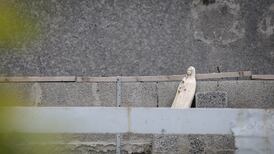Ireland's aggressive approach to wiping out Bovine Spongiform Encephalopathy (BSE) has led to a 40 per cent drop in cases so far this year, according to the Minister for Agriculture and Food. Mr Walsh said that while BSE could not yet be consigned to history, his experts believed this downward trend would continue.
"We are this year seeing a marked decline in BSE numbers, 150 to date in 2003 as compared to 272 in the same period last year," he told journalists yesterday.
"This is a year-on-year decrease of over 40 per cent. What is even more encouraging is that the age profile of confirmed cases continues to strongly support our belief that this trend of decline will continue," he said.
"In 2000-2001, the percentage of animals diagnosed with BSE at six years of age or less stood at 40 per cent and 16 per cent respectively.
"Animals in this age category represent only 2 per cent of confirmed cases in 2003.
"This is incontrovertible evidence of the effectiveness of our controls and of the fact that BSE is being worked out of the national herd as older animals are slaughtered or die," the Minister said.
Mr Walsh said that he expected the total number of confirmed cases of the disease to be in the region of 200 by the end of this year, compared to 333 last year.
His assertion that "odd, surprising or perplexing cases" would continue to occur for some time was confirmed by the Department's senior BSE expert, Dr Hazel Sheridan.
She said Ireland already had two cases of young animals born after 1997 when the ban on feeding meat and bonemeal to cattle became fully operable.
The manufacture of pig and poultry feed was also segregated from cattle feed production.
In Britain there were 55 such cases, called BARB cases (born after real ban), and these were under investigation by the British authorities.
She said the recent case in Japan of what could be a new strain of the disease - and possible links to it with two cases in Italy - was also being investigated.
However, until more such cases emerged she thought the Japanese case would have little impact on the situation.
She also said a predicted BSE model, drawn up by Imperial College, London, indicated that the number of cases could be as low as 29 in 2006 or as high as 54, depending on the accuracy of this assumption.
She also signalled that there could be some changes in the controls in place here, especially the testing of all animals over 30 months old which are destined for human consumption.
The European Commission has come under pressure from the beef-processing industry to reduce the cost of tests.
Details were also given yesterday of the Department's programme to eliminate the disease scrapie from the national sheep flock.
The Department's expert on scrapie, Mr John Griffin, said that when sheep were infected with BSE in laboratory conditions, they exhibited the clinical signs of scrapie.
In 2001 the Republic had adopted a slaughter policy where scrapie was found in Irish flocks, and introduced active surveillance at slaughterhouses and knackeries.
An evaluation of the potential of genotyping to begin breeding flocks resistant to the disease was also started.
That policy was now being refined as flocks resistant to the disease were increasing.
So far this year 32 new flocks had been identified with the disease, but the Department was now not insisting on slaughtering the entire flock, Mr Griffin said.
Infected animals would be destroyed, and animals without resistance could be slaughtered or exported, while farmers would be assisted in replacing the sheep with animals resistant to the disease.
An officially validated genotyping service and voluntary breeding programmes were being put in place.
The 2000 pedigree herds here were being genotyped.







